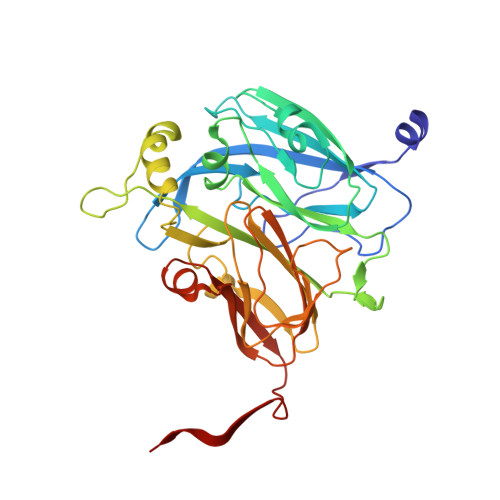Conserved Active Site Residues Limit Inhibition of a Copper-Containing Nitrite Reductase by Small Molecules.
Tocheva, E.I., Eltis, L.D., Murphy, M.E.P.(2008) Biochemistry 47: 4452-4460
- PubMed: 18358002
- DOI: https://doi.org/10.1021/bi7020537
- Primary Citation of Related Structures:
2E86, 2PP7, 2PP8, 2PP9, 2PPA - PubMed Abstract:
The interaction of copper-containing dissimilatory nitrite reductase from Alcaligenes faecalis S-6 ( AfNiR) with each of five small molecules was studied using crystallography and steady-state kinetics. Structural studies revealed that each small molecule interacted with the oxidized catalytic type 2 copper of AfNiR. Three small molecules (formate, acetate and nitrate) mimic the substrate by having at least two oxygen atoms for bidentate coordination to the type 2 copper atom. These three anions bound to the copper ion in the same asymmetric, bidentate manner as nitrite. Consistent with their weak inhibition of the enzyme ( K i >50 mM), the Cu-O distances in these AfNiR-inhibitor complexes were approximately 0.15 A longer than that observed in the AfNiR-nitrite complex. The binding mode of each inhibitor is determined in part by steric interactions with the side chain of active site residue Ile257. Moreover, the side chain of Asp98, a conserved residue that hydrogen bonds to type 2 copper-bound nitrite and nitric oxide, was either disordered or pointed away from the inhibitors. Acetate and formate inhibited AfNiR in a mixed fashion, consistent with the occurrence of second acetate binding site in the AfNiR-acetate complex that occludes access to the type 2 copper. A fourth small molecule, nitrous oxide, bound to the oxidized metal in a side-on fashion reminiscent of nitric oxide to the reduced copper. Nevertheless, nitrous oxide bound at a farther distance from the metal. The fifth small molecule, azide, inhibited the reduction of nitrite by AfNiR most strongly ( K ic = 2.0 +/- 0.1 mM). This ligand bound to the type 2 copper center end-on with a Cu-N c distance of approximately 2 A, and was the only inhibitor to form a hydrogen bond with Asp98. Overall, the data substantiate the roles of Asp98 and Ile257 in discriminating substrate from other small anions.
- Department of Microbiology and Immunology, Life Sciences Institute, University of British Columbia, 2350 Health Sciences Mall, Vancouver BC, V6T 1Z3, Canada.
Organizational Affiliation:





















